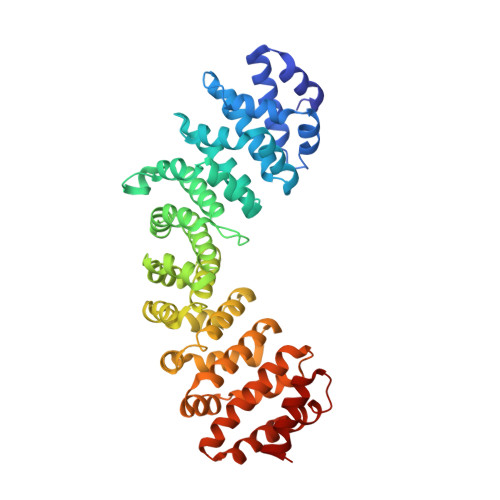Phospholipid Scramblase 1 Contains a Nonclassical Nuclear Localization Signal with Unique Binding Site in Importin alpha
Chen, M.-H., Ben-Efraim, I., Mitrousis, G., Walker-Kopp, N., Sims, P.J., Cingolani, G.(2005) J Biol Chem 280: 10599-10606
- PubMed: 15611084
- DOI: https://doi.org/10.1074/jbc.M413194200
- Primary Citation of Related Structures:
1Y2A - PubMed Abstract:
Nuclear import of proteins containing a classical nuclear localization signal (NLS) is an energy-dependent process that requires the heterodimer importin alpha/beta. Three to six basic contiguous arginine/lysine residues characterize a classical NLS and are thought to form a basic patch on the surface of the import cargo. In this study, we have characterized the NLS of phospholipid scramblase 1 (PLSCR1), a lipid-binding protein that enters the nucleus via the nonclassical NLS (257)GKISKHWTGI(266). This import sequence lacks a contiguous stretch of positively charged residues, and it is enriched in hydrophobic residues. We have determined the 2.2 A crystal structure of a complex between the PLSCR1 NLS and the armadillo repeat core of vertebrate importin alpha. Our crystallographic analysis reveals that PLSCR1 NLS binds to armadillo repeats 1-4 of importin alpha, but its interaction partially overlaps the classical NLS binding site. Two PLSCR1 lysines occupy the canonical positions indicated as P2 and P5. Moreover, we present in vivo evidence that the critical lysine at position P2, which is essential in other known NLS sequences, is dispensable in PLSCR1 NLS. Taken together, these data provide insight into a novel nuclear localization signal that presents a distinct motif for binding to importin alpha.
Organizational Affiliation:
Department of Biochemistry and Molecular Biology, State University of New York Upstate Medical University, 750, E. Adams St., Syracuse, NY 13210, USA.















